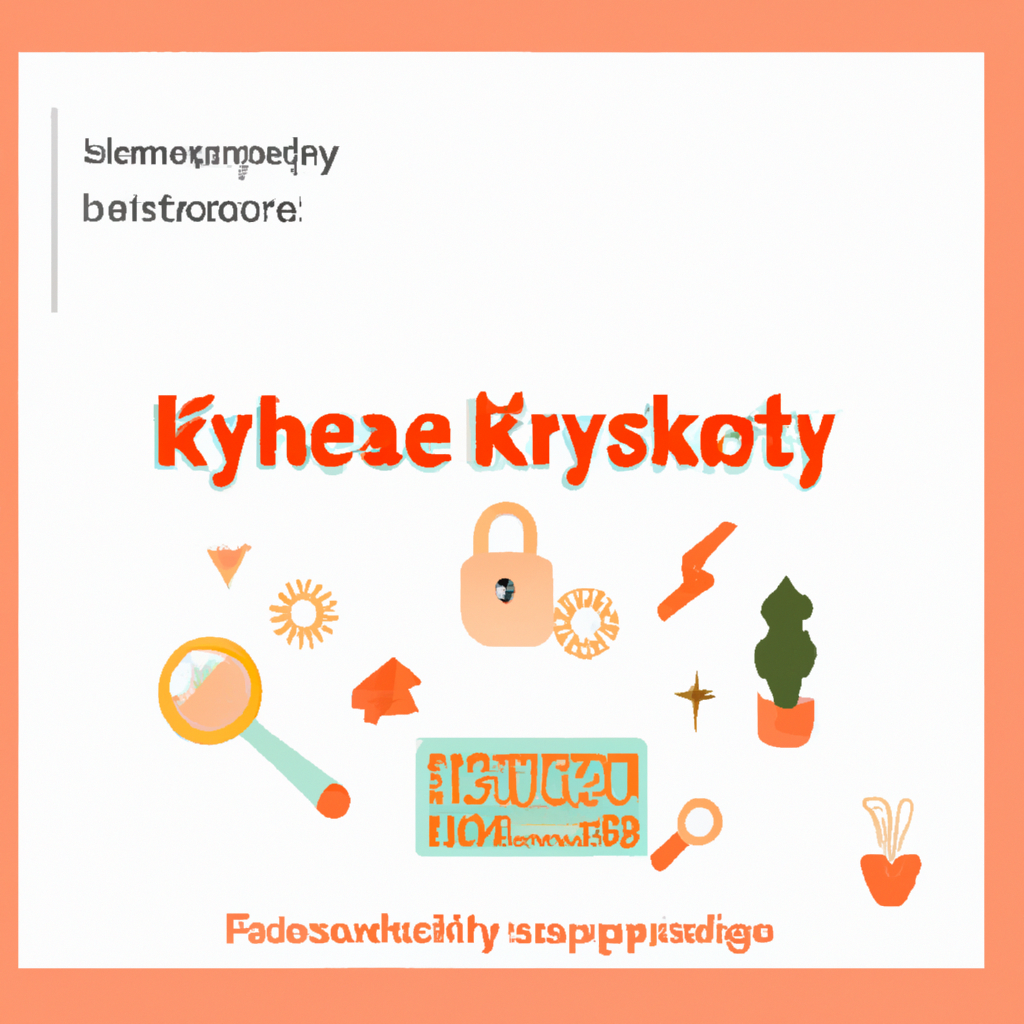Are you an Etsy seller looking to boost your shop’s visibility and drive more traffic? If so, you’re probably wondering how to effectively research keywords on Etsy. Well, look no further! In this article, we will explore the ins and outs of Etsy SEO strategy, discuss the importance of finding low competition keywords, and answer all your burning questions about shop optimization. By the end, you’ll be equipped with the knowledge and tools to improve your Etsy presence and attract more potential buyers to your shop. So, let’s get started and unlock the secrets of successful Etsy keyword research!

Understanding the Importance of Keyword Research on Etsy
Keywords play a crucial role in the success of your Etsy shop. They are the words or phrases that users enter into search engines or Etsy’s search function to find the products they are looking for. By conducting keyword research, you can gain valuable insights into what your potential customers are searching for and optimize your shop to meet their needs.
Why Should You Conduct Keyword Research on Etsy?
Conducting keyword research on Etsy is essential for several reasons. Firstly, it helps you understand the language and terminology that your target customers are using. By aligning your shop with these keywords, you increase the chances of your products appearing in relevant search results.
Secondly, keyword research allows you to identify the competition for specific keywords. By analyzing the popularity and competitiveness of keywords, you can make informed decisions about which ones to target. This can help you optimize your shop to stand out from your competitors and increase your chances of being discovered by potential customers.
How Can Keyword Research Benefit Your Etsy Shop?
Keyword research can benefit your Etsy shop in various ways. By understanding what keywords are relevant to your products, you can improve your visibility in Etsy search results. This means more potential customers will find your shop and browse your products.
Additionally, by targeting specific keywords, you can attract highly relevant traffic to your shop. This means that the people who find your shop through their search queries are more likely to be interested in your products and make a purchase. Ultimately, keyword research can help increase your shop’s visibility, drive targeted traffic, and boost your sales.
What Are the Goals of Keyword Research on Etsy?
The primary goals of keyword research on Etsy are to increase visibility, attract targeted traffic, and boost sales. By identifying the most relevant and popular keywords for your products, you can optimize your shop to appear in search results that align with what potential customers are searching for.
Additionally, keyword research can help you identify untapped opportunities. By analyzing competitor keywords and trends, you can discover new keywords that may have lower competition but still attract significant search volume. This allows you to target niche markets and stand out in a crowded marketplace. Ultimately, the goal of keyword research on Etsy is to position your shop for success and maximize your chances of reaching your target audience.
Using Etsy’s Search Function for Keyword Research
Etsy’s search function is a valuable tool for conducting keyword research. By understanding how to best utilize this feature, you can gain valuable insights into popular search terms and find keywords that are relevant to your products.
Utilizing Etsy’s Autocomplete Feature
One way to leverage Etsy’s search function for keyword research is by utilizing the autocomplete feature. When you start typing a keyword in the search bar, Etsy provides suggested search terms based on popular searches that other users have performed. These suggestions can give you valuable insights into the language and terminology that potential customers are using.
To make the most of the autocomplete feature, start typing relevant keywords related to your products. Pay attention to the suggested search terms that appear, as they can provide additional keyword ideas that you may not have considered. This can help you discover new keywords to incorporate into your shop’s optimization strategy.
Leveraging Etsy’s Search Filters
Another way to use Etsy’s search function for keyword research is by leveraging the search filters. When you perform a search on Etsy, you can apply various filters to narrow down the results based on criteria such as price, location, and item specifications.
By experimenting with different search filters, you can gain insights into how customers are searching for products within your niche. Pay attention to the filters that are frequently used by your target audience, as this can help you identify additional keywords to target and optimize your listings accordingly. Understanding how customers browse and filter search results can provide valuable insights for your keyword research efforts.
Tools to Aid Keyword Research on Etsy
While Etsy’s search function is a valuable tool for keyword research, there are also external tools that can further enhance your keyword research process. These tools provide additional data and insights to help you optimize your shop for maximum visibility and sales.
EtsyRank
EtsyRank is a powerful keyword research tool specifically designed for Etsy sellers. It provides a wealth of information about keywords, listings, and competitors. With EtsyRank, you can analyze keyword competition, find keyword suggestions, track keyword rankings, and much more.
One of the most useful features of EtsyRank is the Keyword Explorer. This tool allows you to enter a keyword and retrieve valuable data such as search volume, competition, engagement, and trends. By using EtsyRank, you can make data-driven decisions about which keywords to target and optimize your shop accordingly.
Marmalead
Marmalead is another popular keyword research tool for Etsy. It offers various features to help you understand keyword trends and optimize your shop effectively. With Marmalead, you can analyze keyword competition, discover trending keywords, track keyword performance, and even get insights into competitor keywords.
Marmalead’s keyword brainstorming feature is particularly useful for generating keyword ideas. By entering a specific keyword or phrase, you can explore related terms and find potential keywords to target in your shop’s optimization. Marmalead provides valuable data to guide your keyword research process and improve your shop’s visibility on Etsy.
Google Keyword Planner
While not specifically designed for Etsy, Google Keyword Planner is a widely-used keyword research tool that can also be valuable for Etsy sellers. By entering relevant keywords, Google Keyword Planner provides insights into search volume, competition, and keyword trends.
Google Keyword Planner can help you discover new keyword ideas that may be relevant to your Etsy shop. By understanding the language and search behavior of potential customers, you can optimize your shop to align with the keywords they are searching for. While not tailored specifically for Etsy, Google Keyword Planner can still be a useful tool in your keyword research arsenal.
Analyzing Competitor Keywords on Etsy
Analyzing competitor keywords on Etsy can provide valuable insights into successful strategies and help identify new keyword opportunities. By understanding what keywords your competitors are targeting, you can refine your own keyword list and optimize your shop to stand out from the crowd.
Identifying Successful Competitors
Before you can analyze competitor keywords, you need to identify your successful competitors. Look for shops that are similar to yours and have a strong presence on Etsy. These are the shops that are most likely targeting keywords and attracting a significant amount of traffic and sales.
Pay attention to factors such as their number of reviews, ratings, and overall shop performance. These can indicate the success of their keyword strategies. By identifying successful competitors, you can learn from their strategies and optimize your own shop accordingly.
Analyzing Competitor’s Shop and Listing Keywords
Once you have identified your competitors, it’s time to analyze their shop and listing keywords. Start by examining their shop titles, descriptions, and tags. These are the areas where keywords are commonly utilized to optimize visibility in search results.
Pay attention to the language and terms they use. Look for patterns and keywords that consistently appear across their listings. This can give you insights into the keywords that are working for them and the language that resonates with your target audience.
Evaluating Competitor’s Strategies
In addition to analyzing keywords, it’s essential to evaluate your competitor’s overall strategies. Look for patterns in their product offerings, pricing, and branding. Understand what sets them apart from the competition and how they position themselves in the market.
By evaluating competitor strategies, you can gain insights into why certain keywords and strategies are successful. Use this information to refine your own keyword research and optimization efforts. By learning from your competitors, you can refine your own strategies and increase your chances of success on Etsy.

Generating Keyword Ideas for Etsy
Generating keyword ideas is an important step in the keyword research process. By brainstorming relevant keywords and analyzing popular search trends and tags, you can discover new keywords to target in your Etsy shop.
Brainstorming Relevant Keywords
Start by brainstorming broad keywords that are relevant to your products. Think about the different categories, features, and benefits of your items. Consider the language and terminology that your potential customers might use when searching for products like yours.
For example, if you sell handmade jewelry, relevant keywords could include “handmade jewelry,” “unique necklaces,” “gemstone bracelets,” and “dainty earrings.” Write down as many relevant keywords as possible, as these will form the foundation of your keyword research.
Utilizing Etsy’s Trending Items and Categories
Etsy’s trending items and categories can provide valuable insights into popular search terms. By visiting the “Trending” section on Etsy’s homepage or exploring popular categories related to your products, you can discover keywords that are currently in high demand.
Pay attention to the specific words and phrases used in trending items and categories. These can give you insights into what potential customers are searching for, allowing you to align your shop with popular keywords and trends. By incorporating these popular keywords into your optimization strategy, you can increase your chances of attracting traffic and sales.
Analyzing Popular Etsy Tags
Etsy tags are another valuable source of keyword ideas. Tags are keywords or phrases that sellers can add to their listings to help improve visibility in search results. By analyzing popular tags used by successful shops in your niche, you can gain insights into relevant keywords to target.
Visit the shops of successful competitors and examine the tags they use in their listings. Look for patterns and keywords that consistently appear across their products. These are the keywords that are likely driving traffic and sales, so incorporating similar tags into your listings can help you attract potential customers.
Refining Your Keyword List on Etsy
After generating a list of relevant keywords, it’s important to refine and prioritize them. By filtering high-volume and high-competition keywords, selecting long-tail keywords, and finding low-competition keywords, you can optimize your shop for maximum visibility and target the right audience.
Filtering High-volume and High-competition Keywords
High-volume and high-competition keywords can be challenging to rank for, especially if you are a new or small Etsy shop. While it’s important to target popular keywords, it’s also essential to be realistic about your chances of ranking highly for them.
Consider filtering out keywords with excessively high search volumes or intense competition. Focus on keywords that are still relevant to your products but have a more reasonable level of competition. By targeting keywords with a balance of search volume and competition, you can increase your chances of ranking higher in search results.
Selecting Long-tail Keywords
Long-tail keywords are more specific phrases that target a niche market. While they may have lower search volume compared to broad keywords, they often have less competition. Targeting long-tail keywords allows you to attract highly relevant traffic and stand out in a crowded marketplace.
For example, instead of targeting the broad keyword “handmade jewelry,” you could focus on long-tail keywords like “handmade silver necklace with gemstone pendant” or “custom name initial charm bracelet.” These keywords are more specific and attract customers looking for precisely what you offer.
Finding Low-competition Keywords
Finding low-competition keywords can be an effective strategy for Etsy shops that are still establishing themselves or targeting niche markets. By identifying keywords with lower competition, you increase your chances of ranking higher in search results and attracting targeted traffic.
Tools like EtsyRank and Marmalead can help you identify low-competition keywords. Look for keywords with moderate search volume and engagement but lower competition scores. These are the keywords that are often less targeted by other sellers, giving you an opportunity to stand out and attract potential customers.
Optimizing Your Etsy Shop with Keywords
Once you have refined your keyword list, it’s time to optimize your Etsy shop to maximize visibility and attract the right audience. By incorporating keywords into your shop titles, writing keyword-rich shop descriptions, using keywords in listing titles and descriptions, and tagging items with relevant keywords, you can improve your shop’s visibility and drive targeted traffic.
Incorporating Keywords into Shop Titles
Shop titles are one of the most important areas to incorporate keywords. Include relevant keywords that accurately describe your shop and the products you offer. This helps Etsy’s search algorithm understand the focus and purpose of your shop, increasing your chances of appearing in relevant search results.
For example, if you sell handmade soaps, a relevant shop title could be “Natural Handmade Soaps | Artisan Soap | Organic Bath Products.” By including keywords like “handmade soaps,” “artisan soap,” and “organic bath products,” you improve the chances of your shop appearing in search results for customers looking for these specific products.
Writing Keyword-rich Shop Descriptions
Shop descriptions are another crucial area to incorporate keywords. Write a compelling description that not only explains what your shop offers but also includes relevant keywords. This provides additional context to Etsy’s search algorithm and increases the chances of your shop appearing in relevant search results.
Incorporate relevant keywords naturally and avoid stuffing them unnaturally into your shop description. Balance optimizing for search engines with providing valuable information to potential customers. By striking this balance, you can improve your shop’s visibility and attract customers who are genuinely interested in what you have to offer.
Using Keywords in Listing Titles and Descriptions
In addition to optimizing your shop, it’s essential to incorporate keywords into your listing titles and descriptions. These are the areas where potential customers will see your products in search results, so it’s crucial to make them as relevant and appealing as possible.
Include relevant keywords in your listing titles and descriptions, but ensure that they flow naturally and make sense to potential customers. Avoid keyword stuffing and focus on providing valuable information about your products. By using keywords strategically in your listings, you can improve their visibility in search results and attract highly targeted traffic.
Tagging Items with Relevant Keywords
Tags play a vital role in optimizing individual product listings on Etsy. These are the keywords or phrases that potential customers search for, so it’s important to choose relevant and specific tags that accurately describe your products.
Think about the words and phrases that your target audience might use when searching for products like yours. Use these keywords as tags for your listings. Etsy allows up to 13 tags per listing, so make the most of this opportunity to increase your chances of appearing in relevant search results.
Monitoring Keyword Performance on Etsy
Once you have optimized your Etsy shop with keywords, it’s important to monitor their performance and make adjustments as needed. By tracking impressions and click-through rates, analyzing conversion rates for different keywords, and adapting and updating your keyword strategy, you can continuously improve your shop’s optimization and maximize your chances of success.
Tracking Impressions and Click-through Rates
Impressions refer to the number of times your listings appear in search results. Click-through rates, on the other hand, measure the percentage of impressions that result in clicks. By tracking these metrics, you can gain insights into how your keywords are performing and adjust your strategy accordingly.
Monitor the impressions and click-through rates for different keywords and listings. Identify keywords that have high impressions but low click-through rates. This may indicate that your title or thumbnail is not enticing enough for potential customers to click. By experimenting with different titles, descriptions, and images, you can improve click-through rates and attract more traffic to your shop.
Analyzing Conversion Rates for Different Keywords
Conversion rates measure the percentage of visitors to your shop who make a purchase. By analyzing conversion rates for different keywords, you can understand which keywords are driving the most sales and focus your optimization efforts accordingly.
Identify keywords that have high conversion rates and prioritize them in your keyword strategy. These are the keywords that resonate with your target audience and prompt them to make a purchase. By optimizing your shop for these high-converting keywords, you can attract more customers who are likely to buy.
Adapting and Updating Keyword Strategy
Keyword research is not a one-time task but an ongoing process. As trends change and competition evolves, it’s essential to adapt and update your keyword strategy accordingly. Continuously monitor your keyword performance and make adjustments as needed to stay ahead of the competition and keep your shop optimized for success.
Regularly revisit your keyword list and look for new opportunities. Pay attention to trends, customer feedback, and changes in search behavior. Experiment with different keywords and strategies to see what works best for your shop. By continuously adapting and updating your keyword strategy, you can position your shop for long-term success on Etsy.
Optimizing Your Listings on Etsy
In addition to optimizing your shop with keywords, it’s important to optimize your individual product listings for maximum visibility and appeal. By writing SEO-friendly listing titles, crafting compelling product descriptions, using relevant tags, and optimizing product images with alt text, you can increase the chances of your listings appearing in relevant search results and attracting potential customers.
Writing SEO-friendly Listing Titles
Listing titles are crucial for maximizing visibility on Etsy. Craft SEO-friendly titles that incorporate relevant keywords and accurately describe your products. Avoid generic titles and use specific terms that potential customers are likely to search for.
For example, instead of a generic title like “Necklace,” a more SEO-friendly title could be “Handmade Silver Necklace with Gemstone Pendant | Unique Statement Jewelry.” This title includes relevant keywords like “handmade silver necklace,” “gemstone pendant,” and “unique statement jewelry,” increasing the chances of attracting targeted traffic.
Crafting Compelling Product Descriptions
Product descriptions are your opportunity to showcase the features, benefits, and story behind your products. Craft compelling descriptions that not only include relevant keywords but also provide valuable information and appeal to potential customers.
Use storytelling and descriptive language to bring your products to life. Highlight the unique qualities and benefits that make your products stand out. Incorporate relevant keywords naturally throughout your descriptions to optimize for search engines. By providing a compelling product description, you increase the chances of converting potential customers into buyers.
Using Relevant Tags
Tags play a significant role in Etsy’s search algorithm. Use relevant tags that accurately describe your products and align with the keywords that potential customers are searching for.
Think about the different search terms and phrases that customers might use to find products like yours. Use these keywords as tags for your listings. Ensure that your tags are specific and accurate to increase your chances of appearing in relevant search results.
Optimizing Product Images with Alt Text
Product images are an essential aspect of optimizing your listings on Etsy. While alt text is primarily used for accessibility purposes, it can also provide additional context for search engines. By optimizing your product images with relevant alt text, you can increase the chances of your listings appearing in search results.
Include relevant keywords in your alt text without being spammy or keyword stuffing. Describe the image and the product being featured accurately. By optimizing your product images with alt text, you can enhance both the accessibility and search engine visibility of your listings.
Staying Updated with Etsy SEO Best Practices
Finally, to maintain a successful Etsy shop, it’s important to stay updated with Etsy SEO best practices. The algorithms and ranking factors that Etsy employs are continuously evolving, so it’s crucial to stay informed to ensure that your optimization strategies remain effective.
Keeping Abreast of Etsy Algorithm Changes
Etsy regularly updates its search algorithm to improve the user experience and ensure relevant search results. Stay informed about algorithm changes by reading Etsy’s seller handbook, following Etsy’s official channels, and engaging with the Etsy seller community.
Understanding how the Etsy algorithm works can help you stay ahead of the competition and optimize your shop effectively. Adapt your keyword strategy and optimization techniques as needed to ensure that your shop remains visible and competitive.
Following SEO Blogs and Forums
In addition to staying updated with Etsy’s official channels, it’s also helpful to follow SEO blogs and forums. These platforms provide insights, tips, and best practices for search engine optimization across various platforms, including Etsy.
By expanding your knowledge of SEO beyond Etsy-specific strategies, you can gain a broader understanding of the principles and techniques that drive visibility and traffic. Apply these learnings to your Etsy shop and experiment with different strategies to see what works best for your business.
Continuously Experimenting and Adapting
SEO is not an exact science, and what works for one shop may not necessarily work for another. It’s important to continuously experiment and adapt your optimization strategies to find what works best for your shop.
Try different keyword combinations, titles, descriptions, and tags to see what attracts the most traffic and conversions. Monitor your metrics, such as impressions, click-through rates, and conversion rates, and make adjustments as needed. By continuously experimenting and adapting your optimization strategies, you can refine your approach and increase your chances of success on Etsy.
In conclusion, keyword research is crucial for optimizing your Etsy shop for maximum visibility and sales. By understanding the importance of keyword research, utilizing Etsy’s search function, leveraging external tools, analyzing competitor keywords, generating keyword ideas, refining your keyword list, optimizing your shop and listings, monitoring keyword performance, and staying updated with SEO best practices, you can position your shop for long-term success on Etsy. By continuously refining and adapting your keyword strategy, you can attract targeted traffic, increase your sales, and achieve your goals as an Etsy seller.



